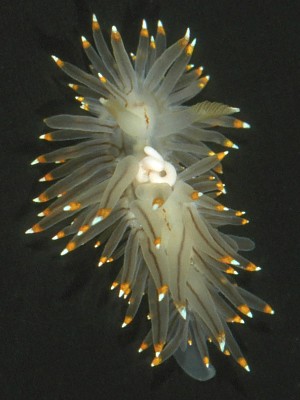Additional information on Janolus fuscus
February 3, 2003
From: Jeff Goddard

Hi Bill,
Here is some information and a photograph to update the Forum’s Fact Sheet for Janolus fuscus. The photograph is of a specimen, 25 mm long, from Cape Arago, Oregon, July 1987. The cream colored, sausage shaped masses extending from the cardiac region are the paired egg masses of the endoparasitic, splanchnotrophid copepod, Ismaila belciki, which infects Janolus fuscus at prevalences as high as 62% (Belcik, 1981; personal observations). Splanchnotrophids can sterilize their nudibranch hosts and therefore probably significantly impact host populations (Schrodl, 1997). At Cape Arago Dirona albolineata and Triopha catalinae are abundant in the same tidepool habitat at the same time (late summer) as Janolus fuscus; they also prey on the same species of bryozoans (Goddard, 1984, 1998, unpublished observations). The copepod, however, is so far known only from Janolus fuscus (Belcik, 1981) and therefore appears to be strongly host-specific.
Janolus fuscus ranges from the Kenai Peninsula, Alaska (Goddard & Foster, 2002) to central California (Behrens, 1991) and preys on arborescent bryozoans, including Bugula pacifica and species of Tricellaria (Goddard, 1998). It overlaps in distribution with the more southerly Janolus barbarensis, but the two species can be distinguished externally by ceratal differences; Janolus fuscus having unbranched digestive gland ducts and orange and white tips and Janolus barbarensis having branched digestive gland ducts and orange and blue tips (Gosliner, 1982; Behrens, 1991). Janolus fuscus hatch from irregularly coiled, cylindrical egg masses as planktotrophic veligers with type 1 shells 138 microns long (Goddard, 2001).
References:
• Behrens, D.W. (1991) Pacific Coast Nudibranchs. Sea Challengers: Monterey, California.
• Belcik, F.P. (1981) The male of Ismaila monstrosa Bergh, 1867 (Copepoda: Splanchnotrophidae). Crustaceana, 40: 16-25.
• Goddard J.H.R. (1984) The opisthobranchs of Cape Arago, Oregon, with notes on their biology and a summary of benthic opisthobranchs known from Oregon. The Veliger, 27: 143-163.
• Goddard, J.H.R. (1998) A summary of the prey of nudibranch mollusks from Cape Arago, Oregon. Opisthobranch Newsletter, 24: 11-14.
• Goddard J.H.R. (2001) Mollusca: Gastropoda. Pp. 86-128. In: A. L. Shanks (ed.), An Identification Guide to the Larval Marine Invertebrates of the Pacific Northwest. Oregon State University Press: Corvallis, Oregon 314 pp.
• Goddard J.H.R. & Foster, N.R. (2002) Range extensions of sacoglossan and nudibranch molluscs to Alaska. The Veliger, 45: 331-336.
• Gosliner, T.M. (1982) The genus Janolus (Nudibranchia: Arminacea) from the Pacific coast of North America, with a reinstatement of Janolus fuscus O’Donoghue, 1924. The Veliger, 24: 219-226.
• O’Donoghue, C.H. (1924) Notes on the nudibranchiate Mollusca from the Vancouver Island region. 4. Transactions of the Royal Canadian Institute, 15: 1-33.
• Schroedl, M. (1997) Aspects of Chilean nudibranch biology: effects of splanchnotrophid copepod parasitism on Flabellina sp. 1. Opisthobranch Newsletter, 23: 45-47.
Jeff Goddard
goddard@lifesci.ucsb.edu
Goddard, J., 2003 (Feb 3) Additional information on Janolus fuscus. [Message in] Sea Slug Forum. Australian Museum, Sydney. Available from http://www.seaslugforum.net/find/9060Thanks Jeff,
There was so little on the Fact Sheet, your contribution is much more than an 'update'. Your information on the parasite Ismaila is an interesting addition to the information we already have on this genus in South America.
Best wishes,
Bill Rudman
Related messages
-
Janolus fuscus from Puget Sound, Washington
From: Jan Kocian, April 21, 2006 -
Janolus fuscus from northern Japan
From: Nishina Masayoshi, July 9, 2004 -
Janolus fuscus from Puget Sound
From: Fraser Stanton, June 28, 2004 -
Janolus fuscus from Alaska
From: Clinton Bauder, August 8, 2002 -
Janolus fuscus from British Columbia
From: Marli Wakeling, June 4, 2000
